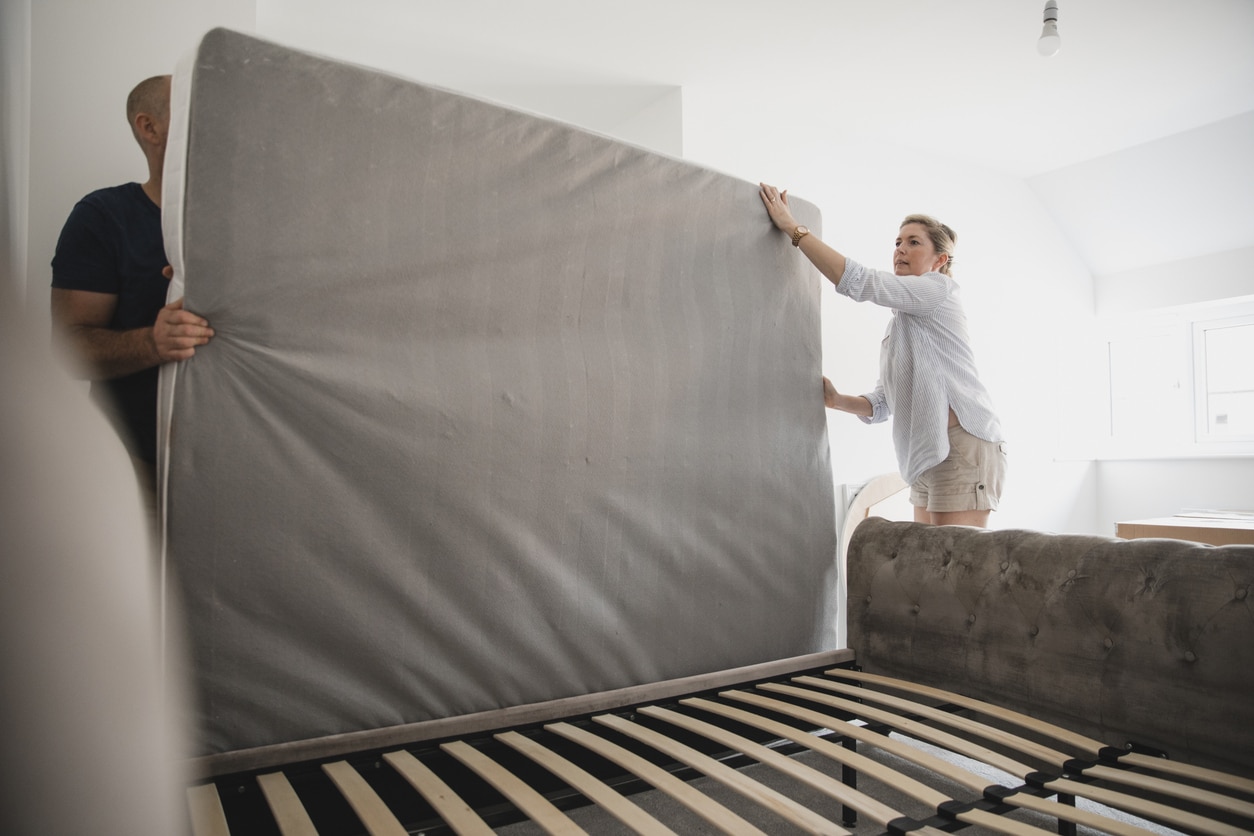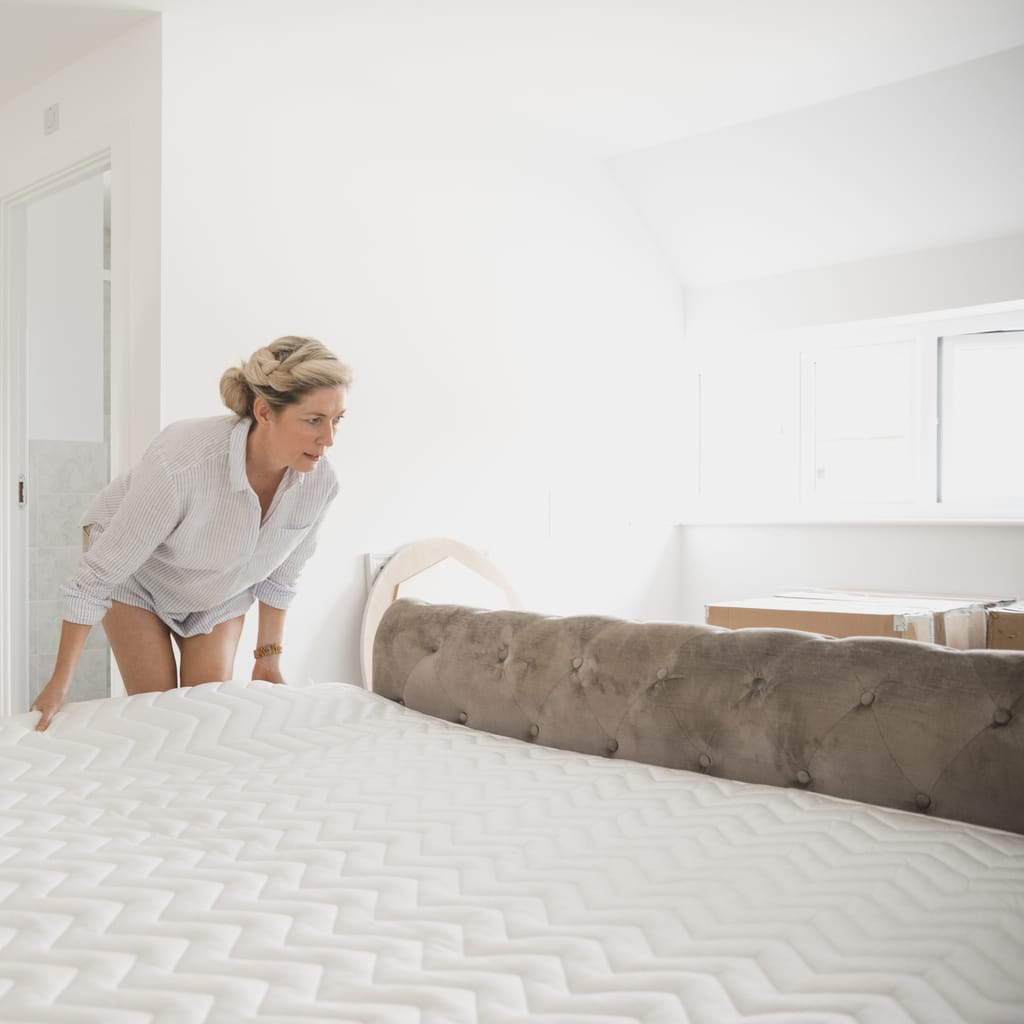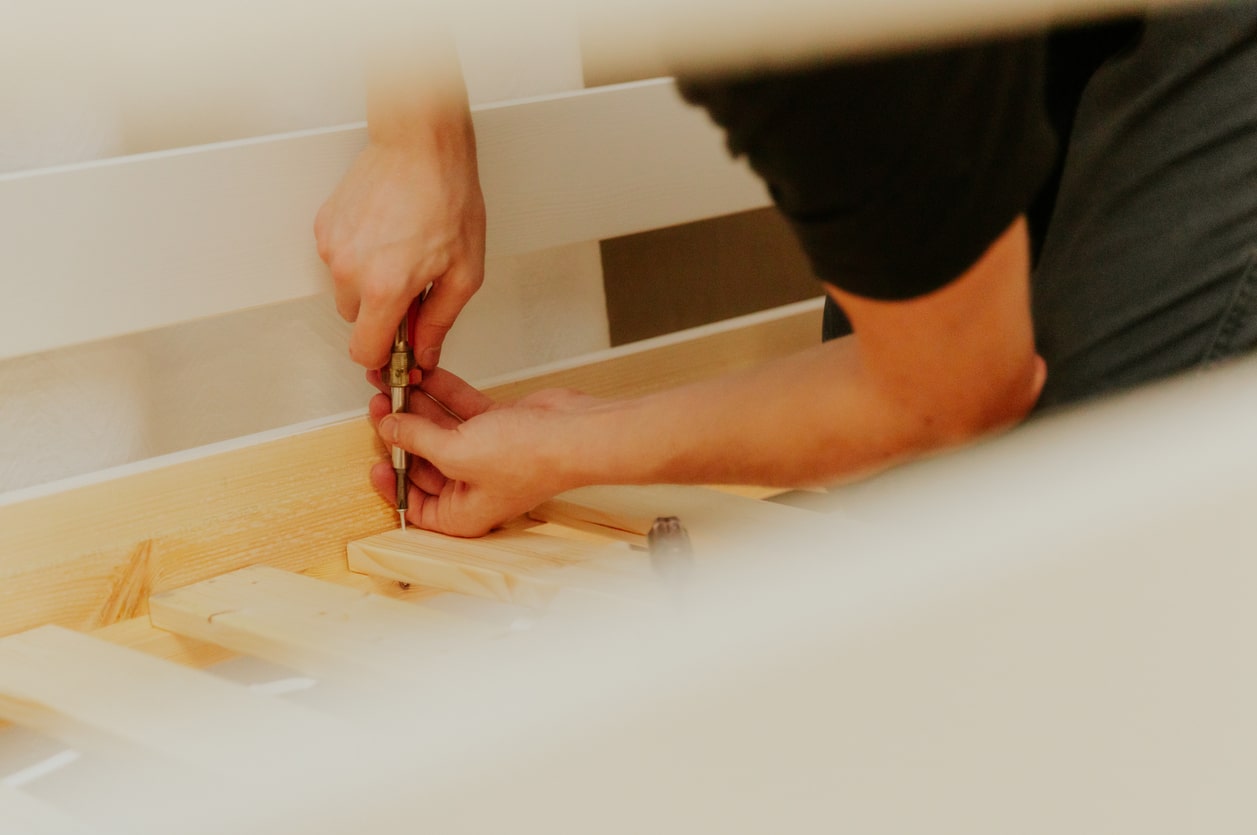When it comes to transporting a bed frame, mattress, and other heavy furniture pieces to your new home, the easiest option is hiring professional movers. But with that said, sometimes you just want to do it yourself.
Whether it’s your first relocation or you’ve done this a couple times before, knowing the nuts and bolts of how to move a bed will save you both time and hassle. So, let’s dig into it — from the necessary supplies and materials you’ll want to stock up on to the step-by-step instructions you’ll need to follow.

How to Move a Bed by Yourself
How do you move a bed? With the right supplies and guidance, you can tackle this project on your own.
Before we break down the steps of how to move a bed by yourself, it’s important to ensure you have all the materials first. Taking care of this ahead of time will streamline the process and minimize the risk of damage or injuries from heavy lifting.
Step #1: Gather supplies for moving the bed frame and mattress
Mattress bags
These thick, durable plastic covers will protect your mattress from dust, moisture, tears, or dirt stains while in transit. They’re also beneficial if you have to transport the mattress from your home to the moving truck in inclement weather or extreme temperatures.
Screwdriver
This handy tool makes it easier to disassemble a metal bed frame, which is held together with screws, nuts, and bolts. You can use a hex tool (also known as an Allen wrench) for this, too. If you have a wooden bed frame, you might need a rubber mallet to carefully disassemble any joints or modular pieces that are fastened with glue instead of screws.
Cling wrap
This stretchable plastic film makes it easy to bundle together disassembled slats or other bed frame pieces, so you won’t lose track of them. If the bed frame has any moving parts—like drawers, for instance—you can also use cling wrap to secure them in place.
Ziploc bags
These resealable plastic bags are ideal for storing loose screws, nuts, bolts, and other small hardware or fasteners. Be sure to label each bag clearly and tape it to the corresponding bed frame piece, so you can locate the right parts when it’s time for reassembly.
Painters tape
This low-adhesive tape won’t leave sticky residue on surfaces, so you can attach those Ziploc bags to the bed frame without causing any potential damage. You can also use painters tape to label each piece and jot down assembly instructions on the frame directly.
Measuring tape
This portable tool allows you to measure the height and width of hallways, staircases, elevators, doors, or other entry points before moving your bed frame pieces and mattress out to the truck. Doing this on the frontend will ensure you won’t get stuck in mid-transport.
Furniture sliders
These felt or plastic discs fit underneath the bottom corners of a mattress and the legs of a bed frame. Furniture sliders make it easier to transport bulky pieces across wood, laminate, tile, or carpet floor without scratching any surfaces or having to lift the furniture.
Moving straps
These adjustable straps enable you to transport a bed frame and mattress safely down stairs without straining or injuring your back. Once these items are in the truck, you can also use moving straps to fasten them securely in place, so they won’t shift around.
Extra set of hands
Moving a bed isn’t a one-person job — not only are the pieces cumbersome, they also require coordination to take apart, maneuver in tight spaces, and lift onto the truck. The easiest, most efficient way to move a bed is to enlist a friend or family member to help.
Step #2: Strip the mattress and pack all your bedding
Now that you have the essential supplies, let’s talk about how to move a mattress. First, strip the comforter and sheets off your mattress and remove the pillowcases from your pillows. If it’s a long-distance move, wash all the bed linens before packing them (you can skip this if it’s a local move and you’ll be unpacking these items the same day).
Since bed linens and pillows don’t weigh much, you can pack them in large boxes or unused plastic trash bags. Pack the bedding for each bedroom together (e.g., your kid’s bedroom in one box and your guest bedroom in another box), then label each box or bag with the contents and corresponding room. This will accelerate unpacking in your new home.

Step #3: Remove the mattress and box spring
1. Pack the mattress and box spring in mattress bags
Clear the surrounding area, then stand the mattress upright on the floor and slip the mattress bag over it from top to bottom. Seal the bag to protect your mattress from dust, moisture, or other particles while in transit. For extra cushioning, reinforce each corner of the bag with tape. Repeat these steps with the box spring in another mattress bag.
2. Label each mattress bag to streamline unpacking
Once each mattress bag is sealed, attach a strip of painters tape to a visible area on the bag, then use a permanent marker to write the contents and corresponding room on the painters tape (e.g., “King Mattress, Primary Bedroom”). This will help whoever is unloading the truck determine where to place each mattress bag in your new home.
3. Transport the mattress bags into your moving truck
Carry each mattress bag on its side out to the moving truck. Enlist at least one other person to share the load if possible, or use moving straps to distribute the weight more evenly and protect your back while lifting it (this is especially crucial if you have to walk down a flight of stairs).
You can also place furniture sliders beneath the bottom two corners of the mattress bag to easily slide it across the floor until you reach the front door.
Next, load each mattress bag inside the truck, then place the bag horizontally on its side against a wall to maximize space and prevent it from bending or slumping. Finally, secure the mattress bag with adjustable straps, so it won’t shift around in transit.
Step #4: Disassemble the bed frame for easier transport
1. Remove the screws and washers, then place them in a bag
This first step will vary based on the material of your bed frame. In terms of how to disassemble a metal bed frame, you'll use either a screwdriver or hex tool to loosen the screws and locking washers (nuts, bolts, and wingnuts) that connect to hollow or adjustable parts.
In terms of a wooden bed frame, you’ll have to take apart more delicate fasteners such as wood dowels or glued joints, so be careful not to strip the screws or damage the finish. You might need a rubber mallet to gently detach these pieces. As you remove each fastener, store it (along with other brackets or hardware pieces) in a Ziploc bag.
2. Bundle together the loose bed frame parts with cling wrap
Once you’ve taken the bed frame apart, group the disassembled parts into bundles of equal sizes and shapes, then secure them with cling wrap.
Make sure these bundles aren’t too heavy to lift (you might need someone else to help carry the long, bulky pieces such as headboards or side rails).
For extra cushioning, cover each bundle in another layer of protective material like bubble wrap—or even towels and linens—to prevent damage in transit.
3. Attach the bag of screws to the bed frame with painters tape
Tightly seal the Ziploc bag and label it with the bed type and corresponding room (e.g., “Queen Bed, Guest Room”). Then, use a strip of painters tape to secure the bag to a flat, visible section of the disassembled frame like a headboard or side rail. This will ensure you don’t lose track of those small but essential hardware pieces during the move.
4. Transport the bed frame to your truck and secure it in place
Now it’s time to carry each bundle out to the truck. If you’re transporting bulkier parts on your own, use straps to minimize the risk of straining your back. If you’re moving a piece of the bed frame across the floor, place a furniture slider beneath it to avoid scratching the surface.
Once all bundles are in the truck, carefully stack them against a wall or brace them upright between sturdy furniture that can support their weight. Next, secure them with adjustable straps, so they won’t shift in transit and sustain damage or collide with other items.

How to Move Different Types of Beds
Now that we covered all the basics of how to move a bed, let’s explore the nuances of moving certain types of beds.
Some bed frames have bulky shapes, modular attachments, or fragile pieces that will require extra steps and more attention to detail. Here’s how to move a bed frame that falls into one of these unique, specialized categories.
More Packing Tips: How to Pack Fragile Items for Moving How to Move Heavy Furniture |
How to move a heavy bed
Due to its heft and size, the easiest way to move a heavy bed is to break it down into small, manageable parts. Both figuratively and literally. (No, you can’t move a bed without taking it apart.)
Once you’ve packed the mattress and box spring, unscrew the bed frame fasteners (just as you would with a lighter frame), then bundle the similarly sized parts with cling wrap. Make sure these bundles aren’t too cumbersome to transport.
Next, clear a path from the bedroom to the moving truck, so you won’t trip and injure yourself or damage any walls or entries. Avoid lifting a heavy bed frame if you can—it’s safer and more efficient to push each bundle across the floor with furniture sliders.
But if you need to transport the bed frame down stairs or maneuver it within tight spaces, lift each bundle one at a time with a moving strap, hold it vertically, and carry the heaviest sections with a partner.
How to move a murphy bed
Since murphy beds attach to the wall, they have complex, intricate mechanisms held together with screws, brackets, and piston or tension spring systems.
Before you start disassembling, consult the owner’s manual for instructions on how to do it correctly, and take photos of each step in the process — this will make it easier to reassemble in your new home.
Remove the screws and other fasteners with a screwdriver or hex tool, then use a PVC tube to carefully ease back on the tension arm until it releases the lock and relaxes the springs. From there, you can detach the murphy bed from the wall and start bundling the loose frame sections with cling wrap. You’ll need at least one helper to move a murphy bed out to the truck, and use moving straps to balance its bulky size, weight, and shape.

How to disassemble a bunk bed
Before you disassemble a bunk bed, remove all the separate attachments such as ladders or guardrails. Then, use a screwdriver or hex tool to unscrew the bolts which connect both the top and bottom bunks.
Enlist a partner to hold the top frame in place while you disconnect the two levels, then set aside the lighter and smaller top bunk frame in one piece.
Next, loosen the screws and washers on the larger, heavier bottom bunk frame to disassemble it.
Place all those hardware pieces in a labeled Ziploc bag, then bundle the disassembled frame pieces in cling wrap and attach the bag to a side rail with painters tape.
How to disassemble a bed with drawers underneath
Some bed frames (particularly wooden frames) come with movable parts, like drawers built into the base.
First, check if these drawers are freestanding units or attached to the frame.
- If they’re freestanding, just slide each drawer out and unscrew any fasteners that connect to the frame.
- If the drawers are attached, you’ll have to take the frame apart to remove them.
Store all fasteners in a labeled Ziploc bag, bundle the frame pieces in cling wrap, then cover each drawer with cling wrap or a heavy blanket to ensure no contents fall out in transit.
Let Colonial Van Lines Handle the Heavy Lifting
Need help disassembling, loading, and transporting a bed? Let Colonial Van Lines take care of it, along with the rest of your move.
With over 50 years of experience in long-distance relocation, our team of highly trained movers has both the expertise and equipment to make sure all your items (including your bed) arrive safely to their final destination. Contact us for a free moving quote today!

